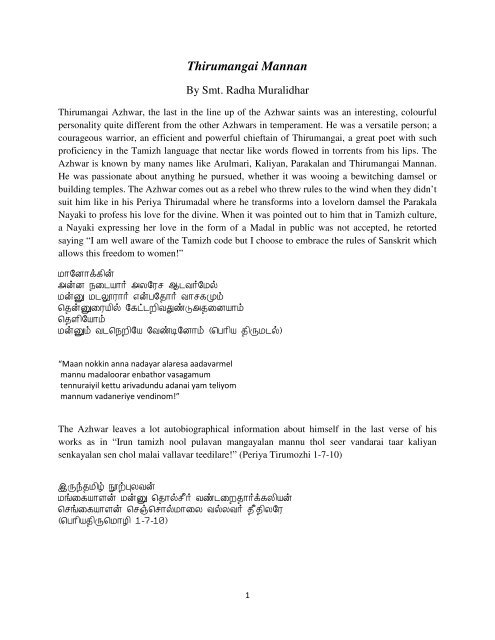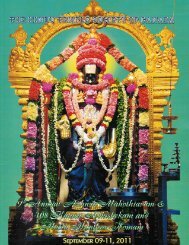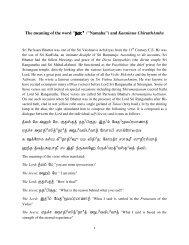Thirumangai Mannan - azhwar.org
Thirumangai Mannan - azhwar.org
Thirumangai Mannan - azhwar.org
You also want an ePaper? Increase the reach of your titles
YUMPU automatically turns print PDFs into web optimized ePapers that Google loves.
<strong>Thirumangai</strong> <strong>Mannan</strong><br />
By Smt. Radha Muralidhar<br />
<strong>Thirumangai</strong> Azhwar, the last in the line up of the Azhwar saints was an interesting, colourful<br />
personality quite different from the other Azhwars in temperament. He was a versatile person; a<br />
courageous warrior, an efficient and powerful chieftain of <strong>Thirumangai</strong>, a great poet with such<br />
proficiency in the Tamizh language that nectar like words flowed in torrents from his lips. The<br />
Azhwar is known by many names like Arulmari, Kaliyan, Parakalan and <strong>Thirumangai</strong> <strong>Mannan</strong>.<br />
He was passionate about anything he pursued, whether it was wooing a bewitching damsel or<br />
building temples. The Azhwar comes out as a rebel who threw rules to the wind when they didn’t<br />
suit him like in his Periya Thirumadal where he transforms into a lovelorn damsel the Parakala<br />
Nayaki to profess his love for the divine. When it was pointed out to him that in Tamizh culture,<br />
a Nayaki expressing her love in the form of a Madal in public was not accepted, he retorted<br />
saying “I am well aware of the Tamizh code but I choose to embrace the rules of Sanskrit which<br />
allows this freedom to women!”<br />
Á¡§É¡ì¸¢ý<br />
«ýÉ ¿¨¼Â¡÷ «Ä§Ãº ¬¼Å÷§Áø<br />
ÁýÛ Á¼æá÷ ±ýÀ§¾¡÷ Å¡º¸Óõ<br />
¦¾ýۨâø §¸ð¼È¢ÅÐñΫ¾¨É¡õ<br />
¦¾Ç¢§Â¡õ<br />
ÁýÛõ ż¦¿È¢§Â §Åñʧɡõ (¦À¡¢Â ¾¢ÕÁ¼ø)<br />
“Maan nokkin anna nadayar alaresa aadavarmel<br />
mannu madaloorar enbathor vasagamum<br />
tennuraiyil kettu arivadundu adanai yam teliyom<br />
mannum vadaneriye vendinom!”<br />
The Azhwar leaves a lot autobiographical information about himself in the last verse of his<br />
works as in “Irun tamizh nool pulavan mangayalan mannu thol seer vandarai taar kaliyan<br />
senkayalan sen chol malai vallavar teedilare!” (Periya Tirumozhi 1-7-10)<br />
þÕó¾Á¢ú áüÒÄÅý<br />
Áí¨¸Â¡Çý ÁýÛ ¦¾¡øº£÷ Åñ¼¨È¾¡÷ì¸Ä¢Âý<br />
¦ºí¨¸Â¡Çý ¦ºï¦º¡øÁ¡¨Ä ÅøÄÅ÷ ¾£¾¢Ä§Ã<br />
(¦À¡¢Â¾¢Õ¦Á¡Æ¢ 1-7-10)<br />
1
There is an amusing anecdote about this tendency of this Azhwar to speak a lot about his own<br />
achievements while singing the praise of the Lord. There lived in the temple of Srirangam a<br />
devotee who was employed for cleaning lamps known as Vilakku Pichchai. This guy used to<br />
keep talking to himself while working. Lord Ranganatha reclining in the Sanctum sanctorum<br />
started conversing with this man out of sheer boredom. He in turn used to report to the Lord all<br />
that was going on in the temple. Not that the Lord didn’t know the news but he chose to amuse<br />
himself with this diversion. Villakku Pichai soon grew a little proud and pompous with this<br />
special attention he received. Once he heard the chanters in the temple reciting the Periya<br />
Tirumozhi verse “Senkamala” wherein the Azhwar speaks about his various titles a bit more than<br />
usual. Pichai brought this to the attention of the Lord and said “Your devotee starts by singing<br />
your praise and ends up singing more about himself!” Lord Ranganatha got annoyed with this<br />
piece of impertinence and remarked “So what is wrong with that? All the fame of Kaliyan is due<br />
to my grace, his devotion to me and is my praise indirectly!” After this interlude, the Lord<br />
withdrew into his Archa code of not speaking to anyone. The above episode mentioned in the<br />
commentary reveals that the Peria Perumal loved Kaliyan and his verses so much that he would<br />
not tolerate any criticism of them.<br />
<strong>Thirumangai</strong> Azhwar was the most prolific writer among the Azhwar saints with six Prabandhas<br />
to his credit. They are in a variety of verses Aasu kavi, Vistara kavi, Madhura kavi and Chithra<br />
kavi. The verses presented in a wide range of poetic meters reveal his command over the Tamizh<br />
language and earned him the title of Naalu kavi perumal. It is said that in a confrontation with a<br />
Nayanmar the Azhwar entered a poetic contest and won the duel hands down. The opponent<br />
gave away his spear (Vel) as a token of submission. To mark this, the Azhwar is always seen in<br />
Archa form with the Vel held in his hand. It is also customary to install the Archa form of his<br />
consort Kumudavalli Naachiyar along with the Azhwar as she was instrumental in bringing him<br />
into the fold of devotion to the Lord and Bhagavatas. The bewitching form of the Azhwar with<br />
his consort at his Avatara Kshetra of Thiruvali Thirunagari captures the hearts of all and<br />
devotees who live around the place cannot stay away without a darshan of their Azhwar for long.<br />
Among the Nalayiram, Kaliyan’s Thirumadals and Thiruvezhukootrirrukkai, a Chithirakkavi,<br />
which forms a chariot in words, are very special. Aaravamudha Azhwan, the Lord of<br />
Thirukkudandai who is held to be very enchanted with the Arulicheyal and Azhwar saints has<br />
this unique privilege to be adored by Kaliyan with this remarkable work which is displayed<br />
prominently as a painting in the front corridor of the huge temple. Thirukkudandai also was the<br />
2
first Kshetra to receive this Azhwar’s Mangalasasanam in the very first decad of Peria<br />
Thirumozhi. “Soozh punal kudandaye thozhudu”<br />
ÝúÒÉø ̼󨾧 ¦¾¡ØÐ (¦À¡¢Â¾¢Õ¦Á¡Æ¢ 1-1-2)<br />
In his Periya Thirumadal and Siriya Thirumadal, the Azhwar sings as the Parakala Nayaki. This<br />
bridal mysticism is an expression of the overflowing, boundless love for the divine. The Azhwars<br />
speak in their own words and voice when in full command of their self and speak as the Nayaki<br />
when their love overflows. “Gnana dasayil tan pecchu premadasayil pen pecchu” (“»¡É<br />
¾¢¨ºÂ¢ø ¾ý §ÀîÍ ô§ÃÁ¾¢¨ºÂ¢ø ¦Àñ §ÀîÍ”) says the commentary. The<br />
overflowing Bhagavad Anubhavam needs to be channelised like the overflowing water of a<br />
reservoir in the rainy season which is released through numerous sluice gates. In such situations<br />
we find the saints speaking in many voices as the Nayaki, the Nayaki’s mother voicing concern<br />
over her daughter’s state and as the Nayaki’s friend. In both the Madals, the Azhwar sings<br />
about numerous Divya deshas but dedicates the works to the Lord of Thirunaraiyur in the last<br />
verse.<br />
Oora dozhiyen ulagariya onnudaleer!<br />
Seerar mulaithadangal seralavum- parellam<br />
Anrongi ninralandan ninra thirunaraiyur<br />
Manronga oorvan madal.( Siriya Thirumadal)<br />
°Ã¡ ¦¾¡Æ¢§Âý ¯Ä¸È¢Â ´ñϾģ÷<br />
º£Ã¡÷ Ó¨Äò¾¼í¸û §ºÃÇ×õ - À¡¦ÃøÄ¡õ<br />
«ý§È¡í¸¢ ¿¢ýÈÇó¾¡ý ¿¢ýÈ ¾¢Õ¿¨Èä÷<br />
Áý§È¡í¸ °÷Åý Á¼ø (º¢È¢Â ¾¢ÕÁ¼ø)<br />
Mannir podippoosi vandiraikkum poochchoodi<br />
Pennai madalpidiththu pinpine- annal<br />
Thirunaraiyoor ninrapiran ter pogum veedi<br />
Poru maraiyal selvam polindu ( Periya Thirumadal)<br />
Áñ½¢ü ¦À¡Êô⺢ ÅñʨÈìÌõ âîÝÊ<br />
¦Àñ¨½ Á¼øÀ¢ÊòÐô À¢ýÀ¢ý§É - «ñ½ø<br />
¾¢Õ¿¨Èä÷ ¿¢ýÈÀ¢Ã¡ý §¾÷§À¡Ìõ Å£¾¢<br />
¦À¡ÕÁ¨ÈÂ¡î ¦ºøÅõ ¦À¡Ä¢óÐ (¦À¡¢Â ¾¢ÕÁ¼ø)<br />
3
<strong>Thirumangai</strong> Azhwar went to Thirunaraiyur and sang his delectable verses bewitched by<br />
Nambi’s Soundaryam. Thirunaraiyur Nambi was also the Azhwar’s Acharyan and therefore<br />
commanded a special position in the Azhwar’s heart. Later when Kaliyan returned to Srirangam<br />
the Peria Perumal with evident disappointment confronted him saying “Azhwar! You offered<br />
your special verses as Nayaki to Nambi!” The Azhwar tried to pacify Sri Ranganatha saying<br />
“But I built the huge rampart walls (Madil) of your temple to make it fit to be called the Peria<br />
Kovil. This is a special kainkaryam offered to you alone!” Unconvinced by this explanation<br />
given to placate him, Lord Ranganatha is said to have retorted saying “I would have been<br />
happier if you had offered your Madal to me and built the Madil for Nambi.” This charming<br />
anecdote reveals the magic of Kaliyan’s words that kept the Lord spell bound. It also reminds us<br />
that what protects the Lord and ‘SriVaishnavaSri’ is the benedictory words of the saints not the<br />
massive walls of bricks, stones and mortar built around them.<br />
This Azhwar’s devotion to the Archa form is incomparable. The idol form was vibrantly alive to<br />
him and responded to his faith and entreaties. He was truly the pioneer of the modern trend of<br />
Pilgrimage tourism. One must keep in mind that the Azhwar reached out covering distant<br />
Kshetras like Salagramam, Badri, Naimisaaranyam, Ahobilam in days when most modern<br />
comforts were unknown and transport was primitive. Among the 108 Divya deshas, 86 have<br />
been visited and sung by him unlike the Mangalasasanam of Namm<strong>azhwar</strong> who never stirred<br />
from his abode under the Tamarind tree at Thirukkurugoor. All Namm<strong>azhwar</strong>’s verses on<br />
Kshetras were sung with his Divya Drushti. But <strong>Thirumangai</strong> Azhwar took great pains and<br />
traveled to remote places with great zeal. In his first Prabandham the Periya Thirumozhi he<br />
dedicated decads to each Divyadesha but in later works started singing many temples together.<br />
Periyavachan Pillai’s illuminating commentary throws light on why the Azhwar did this. “The<br />
Azhwar is getting older nearing his departure to Sri Vaikunta. His immense love for Archa<br />
makes him recall all the earlier anubhava. This can be compared to a young girl leaving her<br />
home after marriage. She goes around visiting all the dear ones recalling her joyous days with<br />
them and taking leave with a heavy heart.” This is a sample from his Siriya Thirumadal<br />
“Seerar Thiruvengadame thirrukkovaloore madil kacchi ooragame peragame peramarudirruttan<br />
vellaraye vekkave perali thankal naraiyoor tiruppuliyoor aaramam soozhnda arangam<br />
kanamangai karar mani nirakkannanoor vinnagaram seerar kanapuram serai thiruvazhundoor<br />
4
karar kudandai kadigai kadanmallai erar pozhil soozh idavendai neermalai seeraarum<br />
maaliruncholai thirumogur paror pughazhum vadari vada madurai ooraaya ellam ozhiyame<br />
nanavanai.”<br />
“º£Ã¡÷ ¾¢Õ§Åí¸¼§Á ¾¢Õ째¡Å<br />
æ§Ã, Á¾¢û¸îº¢°Ã¸§Á §Àø§Á<br />
§Àá ÁÕ¾¢Úò¾¡ý ¦ÅûǨȧ ¦Åu¸¡§Å<br />
§ÀáĢ ¾ñ¸¡ø ¿¨Èä÷ ¾¢ÕôÒÄ¢ä÷<br />
¬Ã¡Áõ Ýúó¾ «Ãí¸õ - ¸½Áí¨¸<br />
¸¡Ã¡÷ Á½¢¿¢Èì ¸ñ½ë÷ Å¢ñ½¸Ãõ<br />
º£Ã¡÷ ¸½ÒÃõ §º¨È ¾¢ÕÅØóà÷<br />
¸¡Ã¡÷ Ì¼ó¨¾ ¸Ê¨¸ ¸¼ýÁø¨Ä<br />
²Ã¡÷ ¦À¡Æ¢øÝú þ¼¦Åó¨¾ ¿£÷Á¨Ä<br />
º£Ã¡Õõ Á¡Ä¢Õ狀¡¨Ä - ¾¢Õ§Á¡Ü÷<br />
À¡§Ã¡÷ Ò¸Øõ ž¡¢ żÁШÃ<br />
°Ã¡Â ±øÄ¡õ ´Æ¢Â¡§Á - ¿¡ÉŨɔ<br />
(º¢È¢Â ¾¢ÕÁ¼ø)<br />
<strong>Thirumangai</strong> Azhwar’s devotion to Archa form was total that he rejected Moksha, the land of<br />
eternal bliss where the Muktaatma remains close to the Lord in Celestial form, to be inferior to<br />
Archa worship in this world. “Erar muyal vittu kakkai pin povade” is his bold statement. He is<br />
using the analogy of a hunter pursuing a rabbit abandoning the chase to try and catch a crow<br />
flying in the sky. The rabbit is easier to capture and tastier too is the point here. Archa is likewise<br />
within our reach and is the abode of all auspicious attributes while the celestial form is beyond<br />
reach and the bliss it confers is only hearsay spoken by the scriptures. Archa anubhava is based<br />
on actual experience. To <strong>Thirumangai</strong> Azhwar the Lord came in person with his consort to give<br />
initiation through the Ashtakshari mantra when threatened with a sword. “Vaal valiyal<br />
mandiramkol mangayarkon”. The Azhwar’s love for Archa was special and he in turn demanded<br />
special treatment from the Lord. When he did not get such a treatment or response he threw a<br />
tantrum and poured out his anger in verses, as in the decad on Thiru Indaloor. The Azhwar<br />
reached the temple and found the doors closed and could not contain his disappointment. He said<br />
“O Lord of Indaloor! Scriptures speak of you as the omniscient one! But you seem to know<br />
5
everything other than my presence here at your gate! The shashtras declare that your glorious<br />
form belongs to the bhaktas. What then is the point in closing the gates when I have come all the<br />
way to have your darshan and to sing your praise? Do not consider me to be a submissive bhakta<br />
like the other Azhwars! I cannot tolerate separation from you and I need regular doses of Archa<br />
Anubhavam for survival”. At another Kshetra, Thiruninravoor, there is yet another sweet episode<br />
that drives home the point that the Lord’s of Kshetras needed the Azhwar as much as the Azhwar<br />
needed them. The Azhwar was visiting and singing full decads on each temple Thiruvalloor,<br />
Thiruvallikeni, Thiruneermalai, Thirukkadal mallai, Thiruvidavendai in a sequential order, when<br />
the Goddess of Thiruninravoor drew the attention of the Lord saying “O Lord! Kaliyan the last<br />
among the Azhwars has passed by our temple and we were preoccupied playing a game of dice.<br />
If he doesn’t sing our praise our temple will never be known as a Divya Desha. So please invite<br />
him with befitting honours”. The Lord of the Kshetra did invite the Azhwar who made a passing<br />
reference to him as “Ninravoor nithilaththai” in his verses on Thirukkadalmallai. These two<br />
words from the lips of Kaliyan made this Kshetra one among the revered hundred and eight<br />
Divya Deshas.<br />
<strong>Thirumangai</strong> <strong>Mannan</strong> was a man of action who did not stop with his oral tributes. He was a great<br />
temple builder and raised huge resources to renovate temples. He also praises other kings who<br />
were instrumental in such Kainkarya in glowing words of adoration. His devotion to the other<br />
Azhwar saints and to Bhagavatas in general is legendary. His verse “Sen thamizh paaduvar<br />
thevar” is believed to be a reference to the other Azhwar saints. While he was rebuilding the<br />
walls of the Srirangam temple he was told that a particular spot used to be the spot where<br />
Thondaradipodi Azhwar raised a garden for his Pushpa Kainkaryam. As a mark of deference to<br />
the Azhwar, Kaliyan restructured the Madil around the hallowed spot. Kaliyan also started the<br />
practice of chanting Namm<strong>azhwar</strong>’s prabandhas before the Lord at Srirangam. To perform this<br />
Utsava he used to bring the Archa Moorti of Namm<strong>azhwar</strong> from Azhwar Thirunagari and take<br />
him back after the Utsava with all the temple honours. This marks Kaliyan’s devotion to<br />
Bhagavatas and is also the first instance of according a place to Thiruvaimozhi on par with the<br />
Vedas in temple worship. The Adhyayanotsavam was developed to its present form of Irappathu,<br />
Pagal pathu by Acharya Nadamuni with the chanting of the entire Nalayiram. The essence of<br />
6
<strong>Thirumangai</strong> Azhwar’s life and his words can be summarized as devotion to Archa, Bhagavatas<br />
and the Arulicheyal of the Azhwar saints.<br />
“Vazhi parakalan vazhi kalikanri<br />
Vazhi kurayaloor vazh vendan<br />
Vazhiyaro maayonai val valiyal Mandiram kol<br />
Mangayarkon tooyon sudar mana vel.”<br />
Å¡Æ¢ Àø¡Äý Å¡Æ¢¸Ä¢¸ýÈ¢<br />
Å¡Æ¢ ̨ÈÂæ÷ Å¡ú§Åó¾ý<br />
šƢ§á Á¡§Â¡¨É Å¡ûÅĢ¡ø Áó¾¢Ãí¦¸¡û<br />
Áí¨¸Â÷§¸¡ý<br />
à§Â¡ý ͼ÷Á¡É §Åø.<br />
******************************************<br />
7




